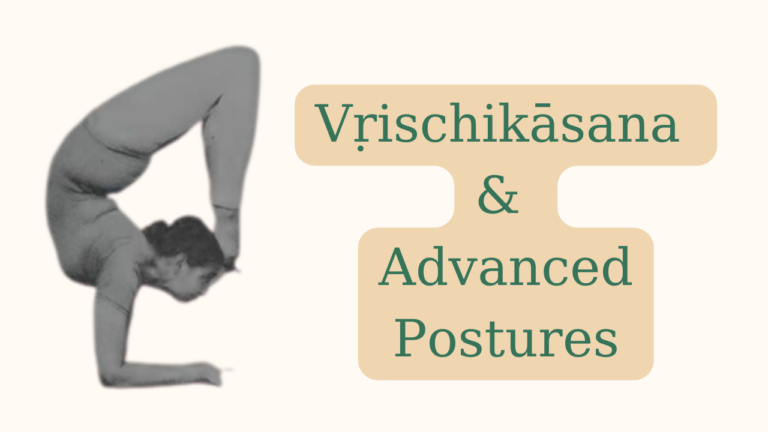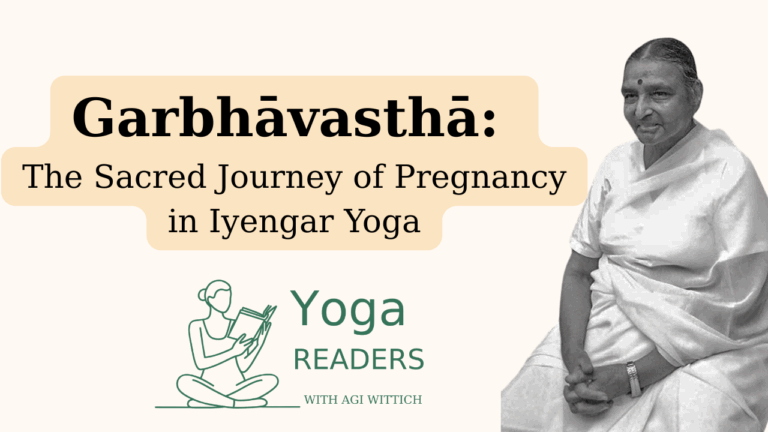
Beyond the Basics: Understanding Advanced Āsanas through Geeta Iyengar’s Wisdom
In the realm of yoga practice, advanced āsanas often spark both fascination
| Reading Unit 7 includes IX Pregnancy Asanas and Pranayama & X Advanced Asanas |
In this part, Geeta focuses on two specialized areas of practice: pregnancy yoga and advanced āsanas. These two chapters from “Yoga: A Gem for Women” showcase Geeta Iyengar’s revolutionary approach to women’s yoga practice across the full spectrum of life experiences. Writing during an era when women faced significant restrictions and misconceptions about their physical capabilities, Geetaji boldly advocated for both the gentle adaptations needed during pregnancy and the empowering challenge of advanced postures. Her teachings demonstrate that intelligent yoga practice can support women through their most vulnerable periods while simultaneously challenging them to reach their highest potential, revealing her profound understanding that true yoga adapts to circumstances without abandoning the fundamental goal of complete human development. Both gentle pregnancy adaptations and challenging advanced practice share the common thread of intelligent adaptation to circumstances while maintaining commitment to growth. Whether supporting a pregnant woman or encouraging an advanced practitioner, the underlying principle remains: yoga practice must evolve to meet current needs while always pointing toward greater wholeness and integration.
Geeta Iyengar’s treatment of yoga practice during pregnancy represents a paradigm shift from the prevailing attitudes of her era. Writing when pregnant women were commonly advised to cease yoga practice altogether, Geetaji courageously advocated for the continuation of thoughtful, adapted practice throughout pregnancy. Her approach was groundbreaking in its recognition of pregnancy as a time when yoga could be particularly beneficial rather than dangerous.
The foundation of Geetaji’s prenatal approach rests on intelligent modification rather than wholesale elimination. She systematically demonstrates how classical asanas can be transformed through the strategic use of props to accommodate the changing body while preserving essential therapeutic benefits. This approach creates space without compression, extending the spine and broadening the pelvic region while ensuring unrestricted breathing.
Remarkably, Geetaji’s approach encompasses not just the physical but the psychological and spiritual dimensions of pregnancy. She acknowledges the profound connection between the mother’s mental state and the developing child’s wellbeing, positioning yoga practice as beneficial for both maternal health and the child’s development. Her month-by-month guidance provides flexible frameworks adaptable for women with varying levels of experience, while her selection of pranayama practices focuses on techniques that soothe the nervous system and prepare for labor.
The chapter on advanced asanas represents Geetaji’s most radical feminist statement. Writing when women’s participation in challenging physical practices was actively discouraged, she boldly asserts that advanced postures are not only within reach of all women but essential for their complete development. Her direct challenge to misconceptions that complicated postures should be avoided after marriage or with advancing age constitutes a revolutionary declaration of women’s capabilities.
Geetaji’s argument extends far beyond physical achievement. She positions challenging poses as superior tools for comprehensive development because their intensity creates more profound effects throughout the entire system. The character development aspect receives particular emphasis—confronting physical and mental challenges cultivates strength of character, stability, intellectual clarity, and a “poised personality.” Her example of Vrschikasana teaching humility through placing feet on head illustrates how physical practice embodies philosophical teachings.
Her systematic categorization includes extreme contractions like Yoganidrasana, arm balancing sequences such as Urdhva Kukkutasana, and intensive backbends like Kapotasana. The eight specific advanced asanas she presents serve as inspirational examples, directing serious students to her father’s “Light on Yoga” for detailed study after mastering foundational work.
Most significantly, Geetaji’s advocacy represents a complete rejection of gender-based limitations in yoga. Her core philosophy emphasizes that physical challenge and spiritual development should not be constrained by gender, marital status, or age—a perspective that was revolutionary for its time and remains relevant today.
1. What is the criteria to differentiate practices for those who began yoga before pregnancy versus those who start during pregnancy?
2. What is the significance of the advanced āsanas presented, and how do they contribute to women’s overall development?
3. How does Geeta adapt traditional practice principles for the specific needs of pregnancy?
Exploring the Sacred Journey: Prenatal Yoga and Advanced Practice in Geeta Iyengar’s Revolutionary Vision
In our seventh reading unit of Geeta Iyengar’s groundbreaking work “Yoga: A Gem for Women,” we embarked on a profound exploration of two seemingly contrasting yet deeply interconnected aspects of women’s yoga practice: the nurturing adaptations required during pregnancy and the empowering challenge of advanced postures. This session revealed the revolutionary nature of Geeta’s teachings, particularly when viewed through the lens of the social and cultural context of the 1970s and 1980s when her book was written.
When Geeta Iyengar wrote about prenatal yoga practice, she was addressing a world where pregnant women were actively discouraged from maintaining their yoga practice. The prevailing wisdom of the time suggested that yoga might be dangerous during pregnancy, potentially harming both mother and developing child. Geeta’s approach was nothing short of revolutionary as she systematically dismantled these fears while providing practical, safe guidance for continuing practice throughout pregnancy.
Her methodology emphasized modifications rather than limitations, demonstrating how traditional asanas could be adapted using props like blankets, blocks, and wall support to create space for the growing child while maintaining the core benefits of each pose. This wasn’t simply about making poses “easier”—it was about intelligent adaptation that honored both the woman’s need for continued practice and the developing life within her.
The session revealed fascinating insights into Geeta’s approach to common pregnancy challenges. Her recommendations for managing nausea, for instance, included a carefully curated selection of postures that might seem counterintuitive at first glance. From supported backbends like Supta Baddha Konasana to the grounding forward fold of Uttanasana and even the reclining position of Supta Virasana, each pose was chosen for its specific therapeutic effect on the digestive and nervous systems. This selection demonstrates the depth of Geeta’s understanding of how different movements and positions affect the body’s internal landscape.
Perhaps most intriguingly, Geeta connected the mother’s practice to the spiritual development of the unborn child. Drawing from ancient wisdom traditions, she suggested that the mother’s mental and spiritual state during pregnancy profoundly influences the developing consciousness of the child. This perspective finds echoes in traditional practices like Garbha Sanskara, where pregnant women are encouraged to engage with spiritual literature, music, and practices that cultivate peace and positive mental states.
Our discussion participants shared contemporary experiences of these ancient practices, revealing how traditional wisdom continues to influence modern prenatal care in Indian communities. The idea that the child in the womb can be influenced by the mother’s exposure to spiritual teachings, exemplified in stories like that of Ashtavakra who learned sacred knowledge while still in utero, bridges ancient understanding with contemporary research on maternal-fetal connection.
The second major theme of our session focused on Geeta’s passionate advocacy for women practicing advanced postures throughout their lives. Here again, we see Geeta challenging prevailing misconceptions of her era. The common belief that complicated postures should be avoided after marriage or discontinued as women age was met with her firm assertion that these beliefs were completely unfounded.
Geeta’s argument went far beyond physical capability. She positioned advanced postures as essential tools for developing not just physical strength and flexibility, but also strength of character, intellectual clarity, and what she termed a “poised personality.” This holistic view of advanced practice aligns with the deeper philosophical understanding of yoga as a complete system for human development, not merely physical exercise.
In her later article “Why Practice Difficult Asana,” Geeta elaborated on this theme, explaining that advanced postures serve as powerful means for confronting our mental limitations, fears, and attachments. The physical challenge becomes a vehicle for psychological and spiritual transformation, forcing practitioners to cultivate qualities like forbearance, faith, and surrender that extend far beyond the yoga mat.
What emerges from Geeta’s teaching is a sophisticated understanding of how challenge and support work together in yoga practice. Her approach to advanced postures often involves the intelligent use of props to make seemingly impossible poses accessible while maintaining their transformative potential. This isn’t about making practice “easier” but about creating pathways for practitioners to safely explore their edges and expand their sense of what’s possible.
The discussion revealed how this approach challenges practitioners to examine their self-imposed limitations. As one participant noted, shifting from “I can’t do this” to “I can’t do this yet” opens up possibilities for growth and learning. This reframing represents a fundamental shift in relationship with challenge and difficulty, viewing them as opportunities for development rather than obstacles to avoid.
Throughout our exploration, we witnessed how Geeta Iyengar’s teachings bridge ancient yogic wisdom with practical modern application. Her understanding of how different postures affect the body’s systems, her recognition of the mind-body connection during pregnancy, and her appreciation for the psychological benefits of challenging practice all reflect a sophisticated integration of traditional knowledge with keen observation and experience.
The session also highlighted how context matters in reading these texts. Understanding the social and cultural climate in which Geeta was writing helps us appreciate the courage required to advocate for women’s full participation in yoga practice. Her work represents not just technical instruction but a form of feminist activism, challenging restrictive beliefs about women’s capabilities and advocating for their right to access the complete spectrum of yogic practices.
As we concluded our session, it became clear that while some of the specific cultural barriers Geeta addressed may have shifted, her core messages remain profoundly relevant. The invitation to maintain practice during pregnancy with intelligent adaptation speaks to contemporary discussions about staying active during pregnancy. Her advocacy for advanced practice challenges ongoing assumptions about aging, capability, and the purposes of yoga practice.
Most importantly, her holistic approach—seeing each pose and practice as an opportunity for comprehensive development of body, mind, and spirit—offers a counterbalance to contemporary trends that might reduce yoga to mere physical exercise or relaxation technique.
Our exploration of these chapters revealed Geeta Iyengar not just as a master teacher but as a visionary who understood yoga’s potential to support women through all phases of life. Her work continues to inspire practitioners to approach their practice with both courage and wisdom, embracing challenge while honoring their body’s needs and limitations.
This session reminded us that reading yogic texts isn’t merely an intellectual exercise but a form of practice itself, one that can deepen our understanding and transform our approach to the physical practices we know and love. As we continue our journey through “Yoga: A Gem for Women,” we carry with us Geeta’s revolutionary spirit and her unwavering belief in women’s capacity for growth, transformation, and spiritual development through the profound practice of yoga.

In the realm of yoga practice, advanced āsanas often spark both fascination

The moment you discover you’re carrying new life, everything changes. Your body
“Writing, Practice, and the Evolution of Iyengar Yoga for Women” This session…
What a joy it was to connect with so many of you…
Reading Unit 1 includes the Forwards, Preface, I First Steps in Yoga,…
Reading Unit 2 includes IV Are Women Eligible for Yoga?, V The…
A Special Session with N. Sine Ozsoy This talk will provide a…
Reading Unit 3 includes VIII Know Your Body, IX Yoga Sadhana, X…
Reading Unit 4 includes I: Standing asana, II: Forward Bends Chapter Summary…
A special exploration for the Yoga Readers community Join a unique session…
Reading Unit 5 includes III Sitting and Supine Asana, IV Inverted Asanas,…
Reading Unit 6 includes VI Asanas: Twists, VII Asanas: Backbends, VIII Asanas:…
Reading Unit 7 includes IX Pregnancy Asanas and Pranayama & X Advanced…
Unit 8 includes XIII On the Threshold of Peace, XIV Hints and…